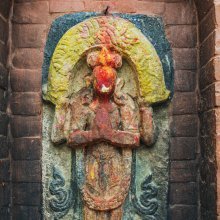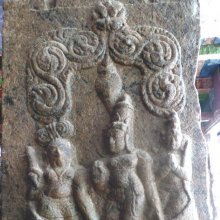Ganga, Gaṅgā, Gāṅga, Gamga: 49 definitions
Introduction:
Ganga means something in Buddhism, Pali, Hinduism, Sanskrit, Jainism, Prakrit, the history of ancient India, Marathi, Hindi, biology. If you want to know the exact meaning, history, etymology or English translation of this term then check out the descriptions on this page. Add your comment or reference to a book if you want to contribute to this summary article.
Ganga has 48 English definitions available.
Images (photo gallery)
(+10 more images available)
Languages of India and abroad
Sanskrit dictionary
[Deutsch Wörterbuch]
Source: Cologne Digital Sanskrit Dictionaries: Böhtlingk and Roth Grosses Petersburger WörterbuchGaṅgā (गङ्गा):—f. [Die Uṇādi-Affixe 1, 122.] der Ganges [Amarakoṣa 1, 2, 3, 30.] [Trikāṇḍaśeṣa 1, 2, 30.] [Hemacandra’s Abhidhānacintāmaṇi 1081.] [Ṛgveda 10, 75, 5.] [The Śatapathabrāhmaṇa 13, 5, 4, 11.] [Kātyāyana’s Śrautasūtrāṇi 13, 3, 20.] [Taittirīyāraṇyaka 2, 20.] [Manu’s Gesetzbuch 8, 92.] [Matsyopākhyāna 18.] [Indralokāgamana 1, 20.] gaṅgāprapāta [Raghuvaṃśa 2, 26.] die Herabkunft der Gaṅgā [Mahābhārata 3, 8831. fgg.] [Rāmāyaṇa 1, 44.] gaṅgā tripathagā (im Luftraum, auf der Erde und in der Unterwelt) [Harivaṃśa 12782.] spaltet sich in 4 Flüsse [Viṣṇupurāṇa 170. 229.] gaṅgā saptavidhā [Mahābhārata 3, 10821.] [Rāmāyaṇa 1, 44, 14. fgg.] [Viṣṇupurāṇa 171,] [Nalopākhyāna 12.] älteste Tochter des Himavant und der Menā [Rāmāyaṇa 1, 36, 15.] Gemahlin Śāntanu’s und Mutter Bhīṣma’s [Mahābhārata 1, 3800.] [Harivaṃśa 2967. fgg.] ihr Verhältniss zu Bhagīratha [810. fgg.] [Rāmāyaṇa 1, 44.] [Viṣṇupurāṇa 379.] zu Jahnu [Harivaṃśa 1417. fgg.] [1757. fgg.] eine der Gemahlinnen Dharma's [Viṣṇupurāṇa 119,] [Nalopākhyāna 12.] ākāśagaṅgā die im Luftraum (vor ihrem Fall zur Erde) strömende G. [Rāmāyaṇa 4, 44, 61.] [Suśruta 1, 114, 5] (wohl die Milchstrasse). vyomagaṅgā [Kumārasaṃbhava 6, 5.] gaṅgāśoṇa n. die Gaṅgā und der Śoṇa [Pāṇini’s acht Bücher 2, 4, 7,] [Scholiast] gaṅgāṣṭaka n. acht Verse an die G. [HAEB.] [Chr. 469. fg.] [Weber’s Verzeichniss No. 1352.] Die 4 Gaṅgā auf Ceylon [Lassen’s Indische Alterthumskunde I, 196.] — Viell. auf gam zurückzuführen.
--- OR ---
Gāṅga (गाङ्ग):—(von gaṅgā)
1) adj. f. ī in oder an der Gaṅgā befindlich, daher kommend u.s.w. [Hemacandra’s Anekārthasaṃgraha 3, 487.] [Medinīkoṣa g. 5.] gāṅgo hradaḥ (vgl. gaṅgāhrada) [Mahābhārata 5, 996.] yāvatyaḥ sikatā gāṅgyaḥ [7, 2215.] āvarta iva gāṅgasya toyasya [Rāmāyaṇa 5, 50, 16.] [Bhartṛhari 3, 88.] [Bhāgavatapurāṇa 3, 20, 5. 8, 6, 13.] gāṅgaiḥ salilairdivaścyutaiḥ [Kumārasaṃbhava 5, 37.] n. (sc. ambu) Regenwasser einer besonderen Art (von der himmlischen Gaṅgā): gāṅgamāśvayuje māsi prāyaśo varṣati [Suśruta 1, 170, 2. fgg.] —
2) m. oxyton. metron. gaṇa śivādi zu [Pāṇini’s acht Bücher 4, 1, 112.] a) Skanda's [Hemacandra’s Anekārthasaṃgraha] [Medinīkoṣa] — b) Bhīṣma’s [Trikāṇḍaśeṣa 2, 8, 12.] [Hemacandra’s Anekārthasaṃgraha] [Medinīkoṣa] [Harivaṃśa 1824.] —
3) f. gāṅgī Beiname der Durgā [Harivaṃśa] [LANGL. 2, 217]; die Calc. Ausg. [10243] : gārgī . — Vgl. gāṅgeya .
--- OR ---
Gaṅga (गङ्ग):—vgl. dviveda .
--- OR ---
Gaṅgā (गङ्गा):—als Frauenname [HALL 175.] [Oxforder Handschriften 281,a,2.]
--- OR ---
Gāṅga (गाङ्ग):—
1) ambu [Spr. 829.] apāṃ pravāho gāṅgaḥ (gāṅgyaḥ v. l.) [3522.]
--- OR ---
Gāṅga (गाङ्ग):—(Nachträge), zur 2ten Stelle vgl. [Spr. (II) 414.]
Source: Cologne Digital Sanskrit Dictionaries: Sanskrit-Wörterbuch in kürzerer FassungGaṅgā (गङ्गा):—f. —
1) der Ganges. Hat weisses Wasser [Indische sprüche 7759.] Floss ehemals im Himmel , von woher Bhagīratha sie auf die Erde leitete. Sie ist die Tochter des Himavant. —
2) ein Frauenname.
--- OR ---
Gāṅga (गाङ्ग):——
1) Adj. (f. ī) in oder an der Gaṅgā befindlich , daher kommend u.s.w. —
2) m. Metron. — a) Bhīṣma’s — b) *Skanda's. —
3) f. ī Beiname der Durgā. v.l. gārgī und gaṅgā. —
4) n. Regenwasser einer besonderen Art.
Sanskrit, also spelled संस्कृतम् (saṃskṛtam), is an ancient language of India commonly seen as the grandmother of the Indo-European language family (even English!). Closely allied with Prakrit and Pali, Sanskrit is more exhaustive in both grammar and terms and has the most extensive collection of literature in the world, greatly surpassing its sister-languages Greek and Latin.
See also (Relevant definitions)
Starts with (+269): Gamgabhavani, Gamgadhisha, Gamgadikara, Gamgagarike, Gamgahimakaravaha, Gamgajamuna, Gamgajul, Gamgajuta, Gamgakaveri, Gamgalamurage, Gamgalamurige, Gamgamauli, Gamganamara, Gamgane, Gamganvaya, Gamgapani, Gamgaphala, Gamgara, Gamgasa, Gamgasamaradhane.
Ends with (+96): Abhraganga, Adhoganga, Adyaganga, Ahoganga, Akashaganga, Alashavara-ganga, Ambaganga, Ambanganga, Antaraganga, Antarganga, Anuganga, Arddhaganga, Ardhaganga, Avattaganga, Avyanganga, Bahalaganga, Banaganga, Barganga, Bhavishyaganga, Bhoganga.
Full-text (+1109): Gangatira, Gangajala, Unmattaganga, Gangodaka, Gangaputra, Gangavatarana, Gangambu, Gangapara, Gangamahatmya, Gangika, Ganga-snana, Gangasagara, Gangahrada, Gangashona, Gangakshetra, Gangabhrit, Saptaganga, Gangaja, Gangacilli, Gangi.
Relevant text
Search found 169 books and stories containing Ganga, Gamga, Gaṃga, Gaṃgā, Gāṃga, Gaṅgā, Gāṅga, Gāṅgā, Gaṅga, Gaṅga°; (plurals include: Gangas, Gamgas, Gaṃgas, Gaṃgās, Gāṃgas, Gaṅgās, Gāṅgas, Gāṅgās, Gaṅgas, Gaṅga°s). You can also click to the full overview containing English textual excerpts. Below are direct links for the most relevant articles:
Garga Samhita (English) (by Danavir Goswami)
Verse 2.3.21 < [Chapter 3 - Description of the Yamunā’s Arrival]
Verse 2.18.22 < [Chapter 18 - The Sight of Śrī Kṛṣṇacandra]
Verse 4.8.33 < [Chapter 8 - In the Story of the Yajña-sītās, the Glories of Ekādaśī]
Chaitanya Bhagavata (by Bhumipati Dāsa)
Verse 3.1.121 < [Chapter 1 - Meeting Again at the House of Śrī Advaita Ācārya]
Verse 2.1.142 < [Chapter 1 - The Beginning of the Lord’s Manifestation and His Instructions on Kṛṣṇa-saṅkīrtana]
Verse 1.13.49 < [Chapter 13 - Defeating Digvijayī]
Dvisahasri of Tembesvami (Summary and Study) (by Upadhyay Mihirkumar Sudhirbhai)
Appendix 5 - Holy places mentioned in the Dvisāhasrī
Appendix 4 - Some Important words employed in the Dvisāhasrī
Biography of H. H. Ṭembesvāmī < [H. H. Ṭembesvāmī: Life, Date & Works]
Matangalila and Hastyayurveda (study) (by Chandrima Das)
The gaja-śārdula concept < [Chapter 2]
Depiction of elephants on the royal seals and inscription-slabs/plates < [Chapter 2]
Bhagavatpadabhyudaya by Lakshmana Suri (study) (by Lathika M. P.)
Canto IV—Depicting of Commentary < [Chapter 2 - Content Analysis of Bhagavatpādābhyudaya]
Hostile Accounts and Controversies < [Chapter 4 - Similarities and Dissimilarities]
Dispute over Śaṅkara’s Birth Place < [Chapter 4 - Similarities and Dissimilarities]
Trishashti Shalaka Purusha Caritra (by Helen M. Johnson)
Part 9: Diversion of the Gaṅga into the moat < [Chapter V - Life and death of the sons of Sagara]
Part 7: The sixth spoke < [Chapter XIII - Śrī Mahāvīra’s nirvāṇa]
Part 8: Leading of the Gaṅga to the Eastern Ocean < [Chapter VI - Emancipation of Ajita Svāmin and Sagara]
Related products
(+5 more products available)










